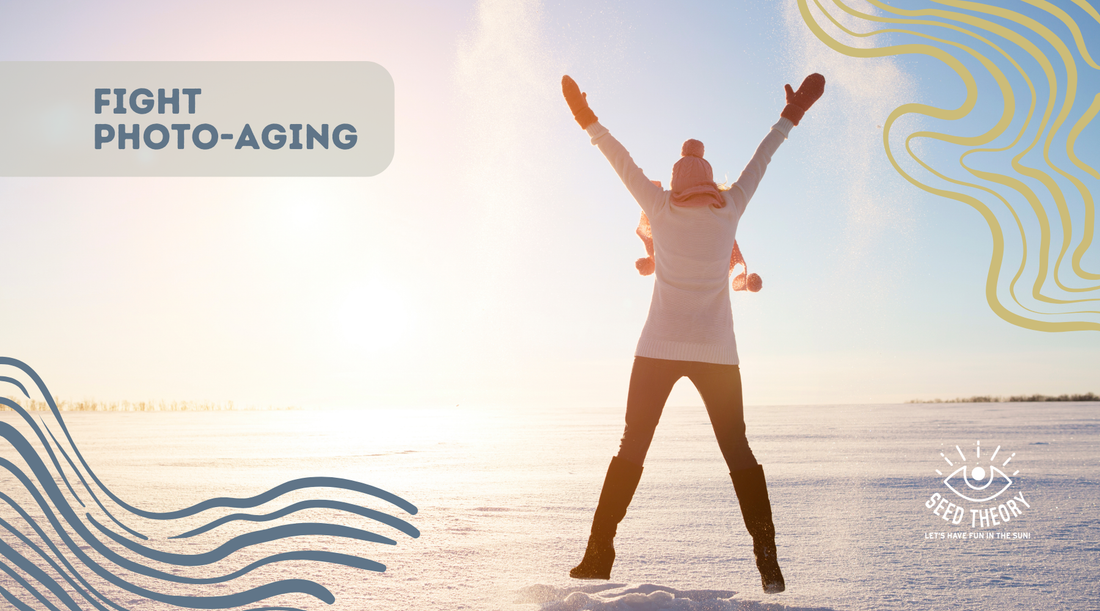
Prevent photo-aging and repair UV damage
Share
When you’re out shopping for skincare products, you probably see the term “anti-aging” all over the place. It’s a great marketing term, and if you’re like me, it generates a powerful emotion–expecially now that I’m in my 40’s and some of my poor sun-protection choices from my youth are starting to show on my face. It’s easy to plant the idea that we can just stop the aging process with a cream and keep our skin looking young forever.
Well, let’s be real. There is no cream or salve or tonic or probiotic that is going to halt the aging process.
As we age, our skin cells, like all cells in our body, begin to change. Synthesis of the proteins that keep our skin stretchy and wrinkle free (elastin and collagen being among some of the really important ones) begins to change. These changes are responsible for wrinkles and sometimes issues like dry or flaky patches. Cells that produce pigments can start to generate those pigments at different rates, which can lead to less even skin tone.
Just remember that these are changes that happen to us all, and it’s important to embrace and love your skin–it’s working really hard every second of every day to keep you happy and healthy.
However, there is another force at work that we most certainly can do something about: photo-aging.
Photo-aging is the premature aging of our skin cells due to UV exposure. Ultraviolet radiation (UV) is basically very high energy light that makes it all the way through the atmosphere and strikes our beautiful faces every time we go outside. Long before you start to get a sunburn, UV can damage your skin cells in many different ways:
-
Damage DNA
- Damaged DNA can hinder your cells’ ability to replicate or hinder their function or even cause cancers. (1) Furthermore, the cells that are responsible for synthesizing collagen and elastin (fibroblasts) are not very good at repairing their DNA and are thus more sensitive to DNA damage from UV exposure.
-
Generate Free Radicals
- UV stress in your skin causes the formation of reactive oxygen species (ROS) or free radicals, which can damage cells and vital proteins in your skin. (2)
-
Break Down Collagen
- UV exposure has been shown to increase the amount of collagen-destroying enzymes in your skin, which can lead to increased wrinkle formation. (3)
-
Dark Spots
- UV can cause increased production of the pigment called melanin, which can lead to dark spots and uneven skin tone. (4)
-
Chronic Inflammation
- Prolonged UV exposure can cause chronic inflammation which increases stress on cells and leads to the breakdown of the structural proteins of your skin, which can lead to a whole host of undesirable skin conditions. (5)
Needless to say, these are all scenarios we’d all like to avoid.
Step 1: Find an SPF product that you love. I use an SPF moisturizer. I know a lot of people who use an SPF make-up product. There are also some pretty cool SPF mists out there. Whatever works for you–just be sure to wear sunscreen!
Step 2: Take care of your skin by treating the cells holistically to prevent and even repair some damage. Here are a few strategies for preventing cellular stress and limiting negative consequences of photo-aging:
-
Keep your skin well-hydrated
- Dehydration is stressful to your skin and can impair its natural defenses against damage. Start with drinking plenty of water. Look for skincare products with ingredients like glycerin or hyaluronic acid or ingredients that include the word “saccharide.” These ingredients bind and hold water in your skin so that the cells can slowly uptake the water.
-
Prevent damage with lots of antioxidants
- I love using botanicals like calendula, green tea, chamomile, and geranium because of their high antioxidant content. Antioxidants greatly limit the ability of free radicals to damage your cells and the structural proteins of your skin. Calendula even has some compounds that actively stop the enzymes that damage collagen and lead to premature aging. (6)
-
When in doubt, try more antioxidants
- I also like to incorporate concentrated antioxidants such as ferulic acid and coenzyme Q10 because of their incredible ability to prevent and repair damage. Ferulic acid helps stabilize other antioxidants, and it can help fight overproduction of melanin. (7) Coenzyme Q10 can help stimulate new collagen synthesis and improve the elasticity and firmness of skin. (8)
-
Protect and seal in moisture
- Using oils or protective moisturizers seals in water and prevents your skin from getting dehydrated during the day and while you sleep. They also help seal out things like bacteria, fungal spores, dirt, and pollution–all of which can further stress skin cells and accelerate the signs of aging.
-
Eat your veggies
- Eating your veggies is always a good idea, but if you’re looking to give your skin a healthy boost, try sticking to anything colorful–think dark greens, vibrant reds or striking oranges. The pigments that make these veggies so pretty are rich in polyphenols, which are a great source of antioxidants and help prevent cellular damage from the inside.
Aging is a natural part of life, but with UV protection, a healthy diet, and a well-chosen skincare routine, you can defend against the factors that can accelerate the aging process. Your skin does an awful lot for you–I highly recommend returning the favor.
References:
- Nishisgori, C. (2015). Current concept of photocarcinogenesis. Photochemical & Photobiological Sciences, 14(10), 1713-1721.
- Pinnell, S. R. (2003). Cutaneous photodamage, oxidative stress, and topical antioxidant protection. Journal of the American Academy of Dermatology, 48(1), 1–19.
- Fisher, G. J., et al. (2002). Mechanisms of photoaging and chronological skin aging. Archives of Dermatology, 138(11), 1462–1470.
- Brenner, M., & Hearing, V. J. (2008). The protective role of melanin against UV damage in human skin. Photochemistry and Photobiology, 84(3), 539–549.
- Bosset, S., et al. (2003). Photoaging: a review of clinical and biological features. Photodermatology, Photoimmunology & Photomedicine, 19(6), 243–251.
- Preethi, K. C., et al. (2009). Antioxidant activity of Calendula officinalis flowers. Fitoterapia, 80(6), 436–440.
- Graf, E. (1992). Antioxidant potential of ferulic acid. Free Radical Biology and Medicine, 13(4), 435-448.
- Prahl, S., et al. (2008). Effects of Coenzyme Q10 on skin aging. Biofactors, 32(1-4), 237-243.
